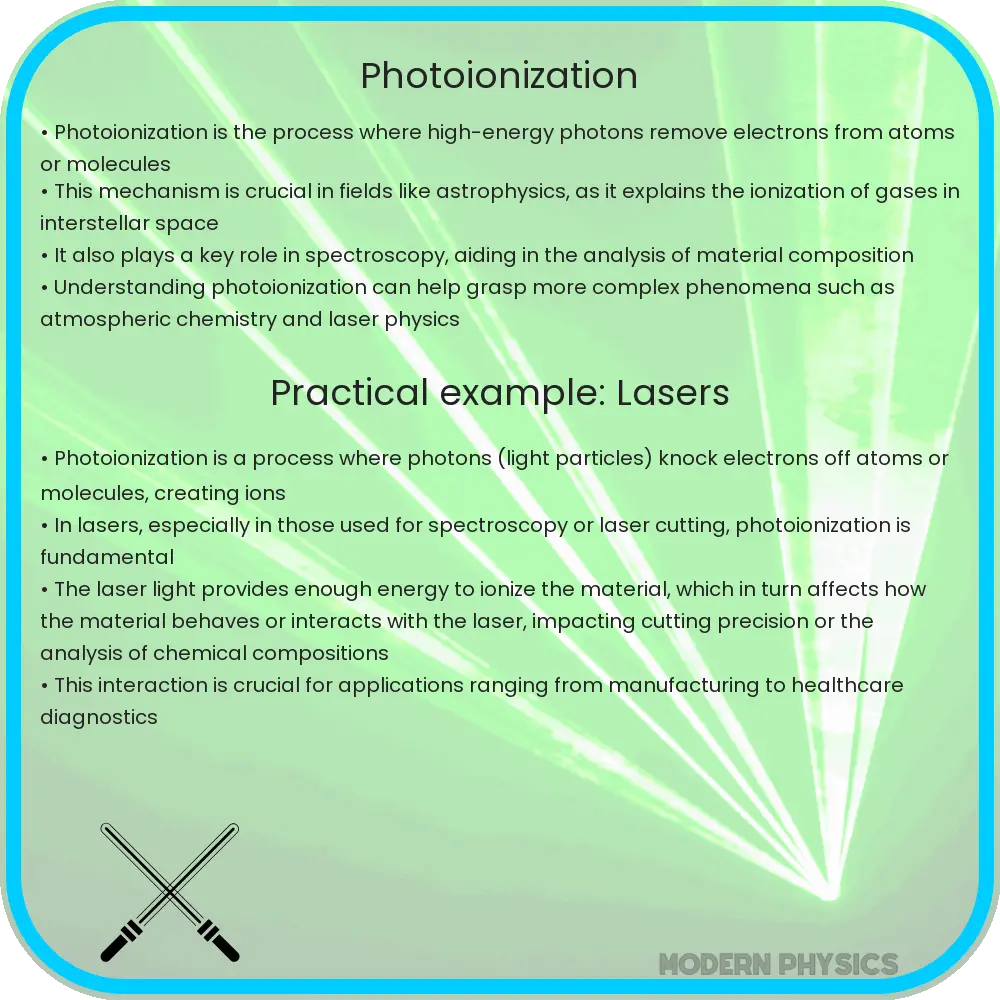Learn about photoionization, the process where atoms absorb photons, ejecting electrons and affecting various scientific fields.

Introduction to Photoionization
Photoionization is a fundamental physical process wherein an atom or molecule absorbs a photon of light, causing an electron to gain enough energy to escape from the atom or molecule. This phenomenon is crucial in various scientific fields including astrophysics, atmospheric science, and spectroscopy. Understanding photoionization not only helps in studying the properties of atoms and the behavior of light but also plays a critical role in technological applications such as mass spectrometry and laser technology.
Basics of Photoionization
The core concept of photoionization revolves around the interaction between light (photons) and matter (atoms or molecules). Photons are particles of light which carry energy quantified by the equation E = h*ν, where “E” represents the energy, “h” is the Planck constant, and “ν” (nu) is the frequency of the light. When a photon with sufficient energy hits an electron within an atom or molecule, it can transfer enough energy to eject the electron out of its atomic or molecular orbit.
The minimum energy required to remove an electron from an atom or molecule is known as the ionization energy. If the photon’s energy (E) is equal to or greater than the ionization energy of the atom or molecule, photoionization can occur. It’s key to note that if the photon’s energy is less than the ionization energy, photoionization does not occur, and other forms of light-matter interaction may take place instead.
Processes in Photoionization
Photoionization can generally be described in two primary processes:
- Single-photon ionization: In this process, a single photon absorbs all the energy required to ionize the atom or molecule. This is straightforward and depends strongly on the intensity and frequency of the light source used.
- Multi-photon ionization: Here, the ionization occurs through the absorption of multiple photons. Multiple low-energy photons collaborate to provide the requisite energy to eject an electron. This process is more complex and is influenced by factors such as the power density of the light and the quantum state of the target atom or molecule.
Both of these processes are significantly influenced by the wavelength and intensity of the inciting light, as well as the nature of the material being ionized. Multi-photon ionization, for example, can lead to nonlinear effects where the ionization probability is not directly proportional to the light’s intensity.
Effects and Applications of Photoionization
Photoionization has diverse effects and several practical applications that permeate different aspects of science and technology:
- Astronomy: Photoionization plays a crucial role in understanding the chemical compositions, densities, and temperatures of celestial bodies. It affects the ionization states found in interstellar mediums, influencing the formation of stars and the characterization of distant galaxies.
- Spectroscopy: In this field, photoionization is used to analyze the composition of various materials by measuring the spectrum of light emitted or absorbed. It’s particularly useful in the study of highly reactive intermediates and radicals in chemical reactions.
- Environmental science: Photoionization detectors are used for monitoring air quality, specifically detecting volatile organic compounds (VOCs) in the atmosphere. The sensitivity of these detectors to specific ionization energies allows for the selective identification of pollutants.
Limitations and Challenges of Photoionization
While photoionization is a powerful tool, it also presents certain limitations and challenges that impact its efficiency and applicability:
- Energy requirement: The effectiveness of photoionization depends on the capability of the light source to provide photons of sufficient energy to overcome the ionization energy. High-energy UV or X-ray photons may be necessary, which can complicate setup and increase costs.
- Sample damage: In sensitive samples, especially in biological materials or fine art conservation, the high energy associated with photoionizing radiation can cause unwanted damage or alteration to the material being studied.
- Complexity in multiphoton processes: The nonlinear dynamics involved in multiphoton ionization require precise control over light intensity and wavelength, as well as a thorough understanding of the quantum mechanical properties of the material, adding layers of complexity to experiments.
Future Prospects
The field of photoionization continues to evolve with advances in laser technology and computational methods. Innovations such as attosecond pulse generation and intense laser fields are opening new pathways for observing and controlling electron dynamics in atoms and molecules with unprecedented precision. Furthermore, the integration of machine learning techniques in data analysis promises to enhance the capabilities of photoionization-based technologies, enabling more accurate and efficient applications.
Conclusion
Photoionization is a versatile and fundamental concept in physics with wide-reaching implications across many scientific disciplines. From astronomy to environmental science, the ability to ionize atoms and molecules using light has fundamentally changed how scientists can manipulate and understand the matter at a very intricate level. Despite its challenges, ongoing technological advancements and increasing computational power continue to broaden the practical limits of this fascinating technique. Understanding the basic principles and applications of photoionization not only enriches our knowledge of the physical world but also spurs innovation in tackling complex problems in science and technology.
